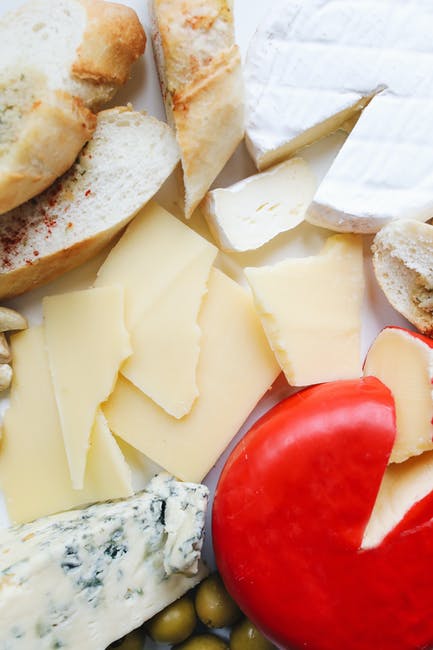By using our website, you agree to the use of cookies as described in our Cookie Policy
Havarti vs. Gouda Cheese: What's the Difference?

There are few snacks more satisfying than cheese.
Don't believe us? Consider a recent study by the U.S. National Library of Medicine. In this study, researchers determined the potency of cheese components and other dairy products makes cheese a highly addictive snack.
We'll admit we're just as addicted to cheese as you are. No matter the occasion, you'll find some kind of cheese on any charcuterie board. Whether that be Gouda cheese, Havarti cheese, or another type - they all keep us happy.
Wondering what the difference is between Gouda cheese and Havarti cheese, specifically? We break it down for you below.
The Making of Cheese
Traditional cheesemaking begins with collecting milk and ensuring it passes proper quality and purity tests so only the best milk is used.
Once the milk product has been approved for processing, additional fat, cream, or protein is added during the filter and standardizing process. Unless the final product is a raw cheese product, the milk will be pasteurized to kill dangerous bacteria.
At this point, cheesemakers add cultures to the milk in order to ferment the milk's lactose, which are the natural sugars in milk. This is when the process starts to differ, depending on the type of cheese you are making. Remember, different types of starter cultures create different types of cheeses.
After adding rennet, the cheese curds begin to separate from the whey and the timing of this step varies based on the type of cheese you are making. Once the curd is completely separated from the whey, cheesemakers start to make the cheese look like it's supposed to! This process varies on the cheese type but will involve either salting and pressing it into a form, or pressing into a hoop, and then brining the cheese.
At Ambassador Foods, one important distinction is the lack of milk fat or creams within its Ammerlander pasteurized milk cheese product. Additionally, Ammerlander cheeses are made with microbial/vegetarian rennet instead of traditional methods. This makes it a great option for vegetarians!
Havarti Cheese
Havarti is a semi-soft cheese with a buttery, creamy flavor. The friendly type of bacteria in Havarti cheese creates small holes or "eyes" just like Swiss cheese!
While the amount of time Havarti ages depends on the cheesemaker, the average Havarti aging process takes a minimum of three months. The longer a cheesemaker chooses to age the Havarti cheese, the firmer, saltier, and nuttier the flavor profile becomes.
What to Pair With Havarti Cheese
Havarti pairs best with sweet fruits and jams. Pears, figs, honeycrisp apples, and raspberry jellies are usually the favorite. For a wine pairing, pair Havarti with a light-bodied wine like pinot noir, rosé, or sauvignon blanc.
History of Havarti Cheese
Havarti was created by Danish farmer Hanne Nielsen during her study of cheesemaking. After traveling around Europe to learn about the varieties of cheeses in various cultures, Nielson returned home to produce her own cheese. The original Havarti recipe was born in the mid-1800s and named after Nielsen's own farm at Havarthigaard, north of Copenhagen.
Gouda Cheese
Gouda is known for its distinct, smoky flavor. It's a true favorite on cheese boards and for use in pasta recipes.
Because "Gouda" is more in reference to the style of cheesemaking involved (see below), Gouda cheeses can vary widely depending on their age. According to Gouda purists, the cheese is really only "true" Gouda if it is made with raw Dutch milk (known as "farmer's cheese").
During the culture process, liquid whey is "washed" to remove extra lactose, which helps keep excess lactic acid from forming, and influences the final flavor. Once the curds press into round molds and brined, the Gouda will dry and age for 1-12 months.
Depending on the aging of Gouda (a very serious process), the cheese may be categorized and priced differently. Gouda types include:
- Young or New Gouda - only aged for 4 weeks
- Young Matured Gouda - aged 8 to 10 weeks
- Matured Gouda - aged 16 to 18 weeks
- Extra Matured Gouda - aged 7 to 8 months
- Fully Matured Gouda - aged 10 to 12 months
- Very Old or Very Aged Gouda- aged over 12 months
Young Gouda cheese is mild, soft, and tastes on the sweeter side. The older Gouda becomes, the harder, stronger, and darker in flavor it becomes.
What to Pair With Gouda Cheese
Young Gouda is best used in sandwiches and on crackers. Mature Gouda is best in macaroni and cheese or on baked bread. Many people like to pair both kinds of gouda with apples and nuts to enhance the flavor of the cheese.
The best pairing for an aged Gouda is a full-bodied red. Try it with a French Bordeaux or Cabernet Franc for a great pairing.
History of Gouda Cheese
Gouda cheese was born in the Netherlands and dates as far back as 1184, actually making it one of the oldest recorded cheeses in history.
Because towns in the Middle Ages earned distinct trading rights through the feudal system, the town of Gouda was known for its cheese trade. Interestingly, Gouda was not actually invented in the town of Gouda, it was merely traded there.
Gouda cheese is technically a style of cheesemaking that involves aging the cheese after brining. The age of the cheese determines a distinct flavor and texture that can vary depending on the producer.
For Gouda "purists," only about 300 Dutch farmers still produce the raw, protected form of Gouda using raw, unpasteurized milk.
Get Your Fix
Feel like a Havarti or Gouda cheese expert yet? If not, don't worry, that's where we come in!
At Ambassador Foods, we are expert-level food lovers. We bake, cook, taste, share, and represent your products at food shows, conferences, sales meetings, or anywhere else you need us to be. If you need to source a food item, our ambassadors can find the right product for your budget and timeline.
Contact us today to kick off a beautiful friendship.
‹ Back








Comments